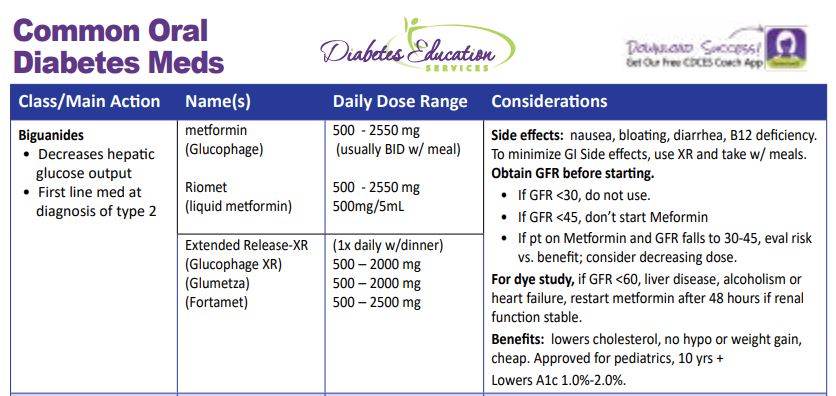Can’t afford Insulin? Strategies that can help
The cost of insulin is a real problem. According to an analysis of data from the CDC’s 2021 National Health Interview Survey, 1.3 million Americans with diabetes, or 16.5% of insulin users in the U.S. rationed their insulin in the past year due to the high costs of this life-saving hormone.
Insulin rationing is more common in adults under the age of 65, middle-income individuals, and Black Americans. This lack of insulin results in chronic hyperglycemia, intensifying the risk of diabetes-related complications, worsening quality of life, and can even lead to hospitalization and death.
In the 2021 National Health Survey, 16.5% of respondents living in the US, rationed insulin in the past year.
The retail price for a box of insulin pens (1,500 units) is about $500. A vial of insulin (1000 units) varies from $160 to $400. For this reason, many insulin companies offer coupons or biosimilar versions of certain insulins. However, these cost savings aren’t enough for many individuals.
Hopefully, the 2022 Inflation Reduction Act, will at least improve insulin access for seniors with Medicare by limiting insulin copays to $35 per month. However, a similar cap for the privately insured was removed from the bill, and copay caps do not aid the uninsured. Further reform is needed to improve access to insulin for all Americans.
Why is insulin so expensive?
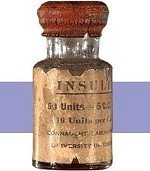
According to a very compelling article published by USC, the insulin distribution intermediaries, or Pharmacy Benefits Managers (PBMs), are significantly contributing to increasing insulin costs.
A USC cross-sectional study of the U.S. insulin market was conducted in 2020 using 2014-2018 data from multiple sources. The study analyzed the flow of funds throughout the insulin distribution system which includes manufacturers, drug wholesalers, pharmacies, health plans, and (PBMs).
According to the USC study, in 2014, 70% percent of insulin revenue was going to the manufacturers and 30% of the insulin revenue went to the PBM middlemen, but by 2018, only 47% was going to the manufacturers. The intermediaries—mostly PBM’s and pharmacies–were pocketing the rest, a whopping 53% share of the revenue from insulin sales.
In light of this complicated insulin distribution system, more needs to be done to uncover these issues and get to the root of unaffordable insulin for the millions of people who rely on it every day.
Here are different strategies to access affordable insulin.
Until we get a handle on the cost of insulin, here is some helpful information and programs that can make insulin more affordable.
Insulin Affordability Guide from ADCES
Insulin Affordability Guide helps make navigation easier ADCES Access & Affordability page with Insulin Cost-Savings Resource Guide. Insulin Cost Savings Guide
ReliOn Insulins $25 a Vial
Walmart and some other pharmacies also offer ReliOn insulins. These include Novolin R, Novolin N, and Novolin 70/30. For people with type 2 diabetes and some with type 1, these insulins offer an affordable option. They are only $25/vial or $44/5 pack of pens and do not require a prescription in most states. Access to these insulins can be truly life-saving in some circumstances. Every person with diabetes needs to be aware that they can purchase these insulins without a prescription if they are ever out of insulin.
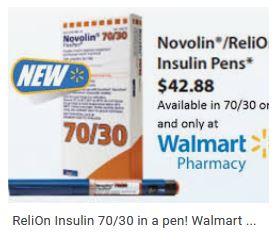
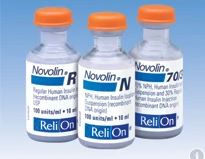
Other Options
Generic Insulins
Because insulin is a biologic drug, a true generic must come from the same manufacturer. Recently Lilly and Novo Nordisk have created generic insulins.
Lilly offers generics of insulin lispro, insulin lispro mix 75/25, and insulin lispro junior kwik pen.
Novo Nordisk offers generics of their insulin, which they are calling a “follow on Brand” and includes insulin apart and insulin Aspart mix 70/30.
Both Lilly and Novo offer approximately 50% cost savings from the original insulin product and the pharmacist can make an automatic substitution if you ask.
Co-Pay Cards
Most insulins offer a co-pay card which can bring down the price of insulin most commonly to $0 to $25/month depending on the manufacturer and type of insulin. For any person with a commercial insurance plan, it’s good to check if a co-pay card is available for the insulin before picking it up from the pharmacy.
The things to be aware of about these cards are that they have maximum savings and sometimes that is much less than the total cost of the insulin. Also, they only work for people with commercial insurance meaning they won’t for people without health insurance or that have a government insurance plan like Medicare. They also do not always work if the drug is not covered by the insurance plan. In that case, it would be preferable to switch to insurance covered by the insurance plan.
Assistance Plans
These are programs offered through pharmaceutical companies for people without health insurance or that have Medicare but still struggle to pay for medications. There are various income requirements to be eligible, but depending on the program it can be 250-400% above the Federal poverty line. Many people are surprised to find that they are eligible, so this is a good option to look into which can make insulin completely free. There is typically a packet of information that needs to be completed and then if eligible, the insulin is shipped to the prescriber’s office for the patient to pick up.
In summary, more needs to be done to make insulin more affordable. As diabetes specialists, we can write to our congresspeople and advocate on behalf of people living with diabetes, to ensure that people no longer have to ration insulin.
References
- ADA Standards of Care – Standard 9, the chart on Average Wholesale Price of Insulin
- Annals of Internal Medicine – Prevalence and Correlates of Patient Rationing of Insulin in the United States: A National Survey, Adam Gaffney, MD, MPH, David U. Himmelstein, MD, Steffie Woolhandler, MD, MPH
- CNN Report on Insulin Rationing
Insulin prices are skyrocketing, but just who is driving the rise in costs? Hint: it’s not the drug manufacturers – USC - For a summary of all this information, see the ADCES Insulin Cost Savings Resources Page.
The use of DES products does not guarantee the successful passage of the CDCES exam. CBDCE does not endorse any preparatory or review materials for the CDCES exam, except for those published by CBDCE.
Question of Week | Bolus insulin to cover steak and salad?

JT tells you, “if I have a steak and salad for dinner, I will give myself 2-3 units of bolus insulin”.
What is the best response?
- That could be dangerous, since bolus insulin is used to cover carbs.
- How many times has your glucose dropped using that approach?
- I am curious to know how that has affected your post meal glucose.
- Giving the insulin after the meal might be a better idea.
Click Here to Test your Knowledge
Want to learn more about this question? Join our NEW
ReVive 5 Diabetes Training Program
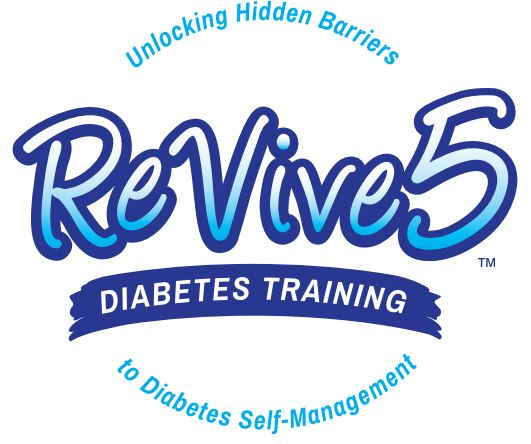
Whether you are a novice or an expert in providing diabetes care, we invite you to attend this exciting training program that provides the essential steps to address diabetes distress combined with an innovative approach to glucose management that will revolutionize your practice.
“ReVive 5” breathes new life into our relationship with diabetes, bringing a fresh perspective to both the person with diabetes and the provider.
Join our Team of Experts
Team of Experts:
ReVive 5 is taught by a team of 3 Interdisciplinary Experts:
- Lawrence Fisher, Ph.D., ABPP, Professor Emeritus, UCSF
- Susan Guzman, PhD
- Beverly Thomassian, RN, MPH, CDCES, BC-ADM
Training Program Includes:
- 14.0 CEs – Includes the 4 Session ReVive Training Program, Certificate and 5 FREE bonus courses to supplement content
(Four 1.5 hour training sessions (6.0 CEs) plus Five bonus courses worth 9.0 CEs for the Deluxe Registration - Quarterly 1 hour follow-up sessions with an expert -dates to be announced
- A comprehensive set of assessment tools, educational materials, log sheets and resources.
Speakers Interviews – Learn more about the ReVive 5 Team
What is the Biggest Takeaway when Addressing Diabetes Distress? – Dr. Susan Guzman
Do you have to be a Mental Health Expert to Tackle Diabetes Distress? – Dr. Lawrence Fisher
Why I Transformed my Approach to Diabetes Self-Management Education- Coach Beverly
Don’t worry if you can’t make it live. Your registration guarantees access to the recorded version in the Online University.
All hours earned count toward your CDCES Accreditation Information
Sign up for Diabetes Blog Bytes – we post one daily Blog Byte from Monday to Friday. And of course, Tuesday is our Question of the Week. It’s Informative and FREE! Sign up below!
The use of DES products does not guarantee the successful passage of the CDCES exam. CBDCE does not endorse any preparatory or review materials for the CDCES exam, except for those published by CBDCE.
Happy World Diabetes Day
I love November because we get to celebrate National Diabetes Month and World Diabetes Day on November 14th, which is Dr. Banting’s Birthday.
One hundred and one years ago, two researchers kick-started the production of insulin, making it available for worldwide use and saving millions of lives. Now, that’s a real cause for celebration. The discovery of insulin by Banting, Best, and team was no easy feat. They encountered resistance, setbacks, and failures.

Dr. Banting secured space to test out his theory at the University of Toronto during a hot summer in 1921. Along with his colleague, Charles Best, and a bare-bones lab, they conducted dozens of experiments on dogs. Marjorie (dog 408) lived for 70 days without a pancreas due to receiving life-saving insulin injections.
This success was replicated in other experimental dogs and ultimately provided the first step toward producing insulin from pig and cow pancreases.
In 1922, children with type 1 diabetes started receiving early doses of this newly available life-saving hormone. Leonard Thompson, was the first recipient in January 1922, followed by many thereafter. Here is a heartbreaking then uplifting photo of J.L., who after 2 months of receiving insulin, transformed into a healthy young boy.
To learn more about the Discovery of Insulin and download historical slides Click here!

We are Celebrating Diabetes Month with Giveaways and 30% Sale on Nov 28th
For the month of November:
- Join or View our 3 FREE webinars
- FREE Tote Bag + Pocket Card with Book or Teaching Tool Purchase
- Cyber Monday Sale – 30% off Online Courses on November 28th.
Sign up for Diabetes Blog Bytes – we post one daily Blog Byte from Monday to Friday. And of course, Tuesday is our Question of the Week. It’s Informative and FREE! Sign up below!
[yikes-mailchimp form=”1″]Accreditation: Diabetes Education Services is an approved provider by the California Board of Registered Nursing, Provider 12640, and Commission on Dietetic Registration (CDR), Provider DI002. Since these programs are approved by the CDR it satisfies the CE requirements for the CDCES regardless of your profession.*
The use of DES products does not guarantee the successful passage of the CDCES exam. CBDCE does not endorse any preparatory or review materials for the CDCES exam, except for those published by CBDCE.
Rationale of the Week | What do new ADA/EASD Standards Recommend?

For last week’s practice question, we quizzed test takers on the new ADA/EASD Standards. 56% of respondents chose the best answer. We want to clarify and share this important information, so you can pass it on to people living with diabetes and your colleagues, plus prepare for exam success!
Before we start though, if you don’t want any spoilers and haven’t tried the question yet, you can answer it below: Answer Question
Question:
The new ADA /EASD Management of Hyperglycemia in Type 2 Consensus Statement 2022 was just released.
Which of the following is an accurate recommendation according to these updated guidelines?
Answer Choices:
- Initiate treatment with metformin for most individuals, including those with cardiovascular disease.
- If A1C not at target with 2 or more oral agents, add on basal insulin therapy.
- Avoid the use of SGLT-2 Inhibitors in those with an eGFR of less than 25.
- Prioritize the use of organ protective medications in those with cardiorenal disease.

Getting to the Best Answer
Answer 1 is incorrect. 15.11% chose this answer, Initiate treatment with metformin for most individuals, including those with cardiovascular disease.” In the past, this would have been the best answer, but based on latest guidelines, metformin is no longer the only first treatment. Based on the individual and our risk assessment (ie heart or renal failure or elevated CV risk) we could choose a SGLT-2 or GLP-1 as first line therapy.
Answer 2 is incorrect. 15.01% of you chose this answer, If A1C not at target with 2 or more oral agents, add on basal insulin therapy.” With the guidelines, they strongly suggest starting a GLP-1 RA before starting basal insulin as the first choice if possible. GLP-1 is preferred since insulin therapy is associated with hypoglycemia and weight gain, while the GLP-1’s is associated with weight loss, CV risk reduction and no hypoglycemia.
Answer 3 is incorrect. 13.87% of respondents chose this answer, “Avoid the use of SGLT-2 Inhibitors in those with an eGFR of less than 25.” This is a juicy answer, but the new guidelines encourage the use of SGLT-2 Inhibitors in people with diabetes with a GFR of 20 or greater, stopping SGLT-2 therapy when dialysis is started. Even with stage 3 & 4 kidney failure, SGLT-2’s can effectively slow the progression of kidney disease and improve CV outcomes in people with diabetes.
Finally, Answer 4 is correct. 56.00% chose this answer, Prioritize the use of organ protective medications in those with cardiorenal disease.” YES, GREAT JOB. This is the best answer. We are encouraged to target therapy based on the individual and to protect organs. For people with renal and heart failure, SGLT-2’s are the preferred class and for people with CV disease, starting either a GLP-1 or SGLT-2 decreases risk of major adverse cardiovascular events (MACE). We hope you can join our webinar on December 1st to learn more.
Want to learn more about this question? Join us for our
Meds for Type 2 Update; New ADA/EASD Consensus Statement
Level 2 | 1.25 CEs
Airs live on Wednesday, December 1st at 11:30 am PST

Plan on joining this exciting webinar that walks participants through the newly released, “Management of Hyperglycemia in Type 2 Consensus Report by the ADA and EASD”. These updated guidelines will be incorporated into the 2023 ADA Standards of Care, but you can get a early sneak peak by joining Coach Beverly on December 1st, 2022. She will highlight the revised guidelines with a focus on new elements and exciting changes on how we approach medication management for type 2 diabetes. Together, we will explore clinical factors to consider when determining the best strategy to improve glucose management in people with type 2 diabetes and other co-conditions. There will be a special focus on cardiovascular risk reduction and renal protection and addressing clinical inertia.
Objectives:
- Describe the role of Diabetes Care and Education Specialists in advocating for optimal therapeutic approaches.
- Discuss the application of the new ADA/EASD Guidelines to improve glucose and reduce CV and renal risk.
- List strategies to initiate and adjust oral and injectable therapy using a person-centered approach
Intended Audience: A great course for health care professionals seeking evidence-based information that improves the quality of life and outcomes.
Don’t worry if you can’t make it live. Your registration guarantees access to the recorded version in the Online University.
All hours earned count toward your CDCES Accreditation Information
Sign up for Diabetes Blog Bytes – we post one daily Blog Byte from Monday to Friday. And of course, Tuesday is our Question of the Week. It’s Informative and FREE! Sign up below!
The use of DES products does not guarantee the successful passage of the CDCES exam. CBDCE does not endorse any preparatory or review materials for the CDCES exam, except for those published by CBDCE.
Question of Week | Why are you worried that RT keeps using same site?

RT says they keep using the same site for their insulin pump, since it doesn’t hurt as much. When you evaluate their abdomen, you notice a large lump at the site.
Why are you worried about this practice?
- Magnified risk of hypoglycemia
- Acanthosis nigricans
- Development of a lipoma
- Decreased insulin absorption
Click Here to Test your Knowledge
It’s election day. Let’s make sure to get to out and Vote!
Want to learn more about this practice question? Join our NEW
ReVive 5 Diabetes Training Program

Whether you are a novice or an expert in providing diabetes care, we invite you to attend this exciting training program that provides the essential steps to address diabetes distress combined with an innovative approach to glucose management that will revolutionize your practice.
“ReVive 5” breathes new life into our relationship with diabetes, bringing a fresh perspective to both the person with with diabetes and the provider.
By releasing old habits that no longer serve us, we have the opportunity to create a new life tool kit toolkit in partnership with the person living with diabetes.
The ReVive 5 program is built on international research study results and will revolutionize your approach to diabetes self-management education.
Join our Team of Experts
Team of Experts:
ReVive 5 is taught by a team of 3 Interdisciplinary Experts:
- Lawrence Fisher, Ph.D., ABPP, Professor Emeritus, UCSF
- Susan Guzman, PhD
- Beverly Thomassian, RN, MPH, CDCES, BC-ADM
Training Program Includes:
- 6.0 CEs – Includes the 4 Session ReVive Training Program, Certificate and 5 FREE bonus courses to supplement content
(Four 1.5 hour training sessions (6.0 CEs) plus Five bonus courses worth 9.0 CEs for the Deluxe version. - Quarterly 1 hour follow-up sessions with an expert -dates to be announced
- A comprehensive set of assessment tools, educational materials, log sheets and resources.
Don’t worry if you can’t make it live. Your registration guarantees access to the recorded version in the Online University.
All hours earned count toward your CDCES Accreditation Information
Sign up for Diabetes Blog Bytes – we post one daily Blog Byte from Monday to Friday. And of course, Tuesday is our Question of the Week. It’s Informative and FREE! Sign up below!
The use of DES products does not guarantee the successful passage of the CDCES exam. CBDCE does not endorse any preparatory or review materials for the CDCES exam, except for those published by CBDCE.
November 2022 eNews | Top 7 Highlights from New Diabetes Consensus
Happy Diabetes Month

We are excited to announce the new ADA/EASD Consensus Statement on the Management of Hyperglycemia in Type 2 diabetes. Coach Beverly has poured through the pages of this document and is thrilled to share her findings with you. Key points are summarized in the blog article below and you are invited to join her upcoming Diabetes ADA/EASD Updates Webinar on Dec. 1st.
To celebrate Diabetes Month and say thank you to our community of diabetes educators and advocates, we are pleased to announce our annual Cyber Monday Sale.
Take 30% off ALL of our online university courses and bundles on November 28th, for one day only.
Given the prevalence of insulin rationing due to the high cost, we explore reasons and provide resources to help. Hopefully, through advocacy and legislation, this life-saving hormone will be made affordable to people with diabetes in the near future.
We detail the new Freestyle Libre 3 glucose sensor, which is not only smaller but offers several critical features that improve ease of use and functionality for individuals and providers alike.
As the holidays roll around, this can be a gastronomically and emotionally challenging time for people living with diabetes. We are happy to share our “Surviving the Holidays” Handout with all of you. Please feel free to print and share it with your community.
Lastly, we encourage you to test your knowledge with our Question and Rationale of the Week.
Happy Diabetes Month and thank you for your care, concern, and advocacy for people living with diabetes. With thanks,
Beverly, Bryanna, and Amanda
Featured Articles
- 7 Takeways from New Guidelines
- Addressing Insulin Rationing
- Freestyle Libre 3
- Surviving the Holidays
- Save the Date, Cyber Monday Sale – 30% off
- Question of the Week
- Rationale of Week
- Meds for Type 2 Webinar
- ReVive 5 Diabetes Training
- The Complete Package
FREE Resources
Join our NEW
ReVive 5 Diabetes Training Program

Whether you are a novice or an expert in providing diabetes care, we invite you to attend this exciting training program that provides the essential steps to address diabetes distress combined with an innovative approach to glucose management that will revolutionize your practice.
“ReVive 5” breathes new life into our relationship with diabetes, bringing a fresh perspective to both the person with with diabetes and the provider.
By releasing old habits that no longer serve us, we have the opportunity to create a new life tool kit toolkit in partnership with the person living with diabetes.
The ReVive 5 program is built on international research study results and will revolutionize your approach to diabetes self-management education.
Join our Team of Experts
Team of Experts:
ReVive 5 is taught by a team of 3 Interdisciplinary Experts:
- Lawrence Fisher, Ph.D., ABPP, Professor Emeritus, UCSF
- Susan Guzman, PhD
- Beverly Thomassian, RN, MPH, CDCES, BC-ADM
Training Program Includes:
- 6.0 CEs – Includes the 4 Session ReVive Training Program, Certificate and 5 FREE bonus courses to supplement content
(Four 1.5 hour training sessions (6.0 CEs) plus Five bonus courses worth 9.0 CEs for the Deluxe version. - Quarterly 1 hour follow-up sessions with an expert -dates to be announced
- A comprehensive set of assessment tools, educational materials, log sheets and resources.
Don’t worry if you can’t make it live. Your registration guarantees access to the recorded version in the Online University.
All hours earned count toward your CDCES Accreditation Information
Sign up for Diabetes Blog Bytes – we post one daily Blog Byte from Monday to Friday. And of course, Tuesday is our Question of the Week. It’s Informative and FREE! Sign up below!
The use of DES products does not guarantee the successful passage of the CDCES exam. CBDCE does not endorse any preparatory or review materials for the CDCES exam, except for those published by CBDCE.
Rationale of the Week | How does Metformin Impact cancer risk?

For last week’s practice question, we quizzed test takers on how Metformin impacts cancer risk. 64% of respondents chose the best answer. We want to clarify and share this important information, so you can pass it on to people living with diabetes and your colleagues, plus prepare for exam success!
Before we start though, if you don’t want any spoilers and haven’t tried the question yet, you can answer it below: Answer Question
Question:
JR is taking Metformin 1000mg BID but is worried that it may increase their risk of cancer and is thinking about stopping the metformin.
Which of the following is an accurate statement regarding metformin, cancer and safety?
Answer Choices:
- There is research suggesting that metformin may be associated with a decreased risk of certain cancers.
- People with diabetes have a slightly lower risk of liver and uterine cancers
- Some brands of metformin were recalled because of an NDMA impurity, so it is best to avoid metformin for now.
- Metformin does not increase the risk of cancer, but it can negatively impact renal function.
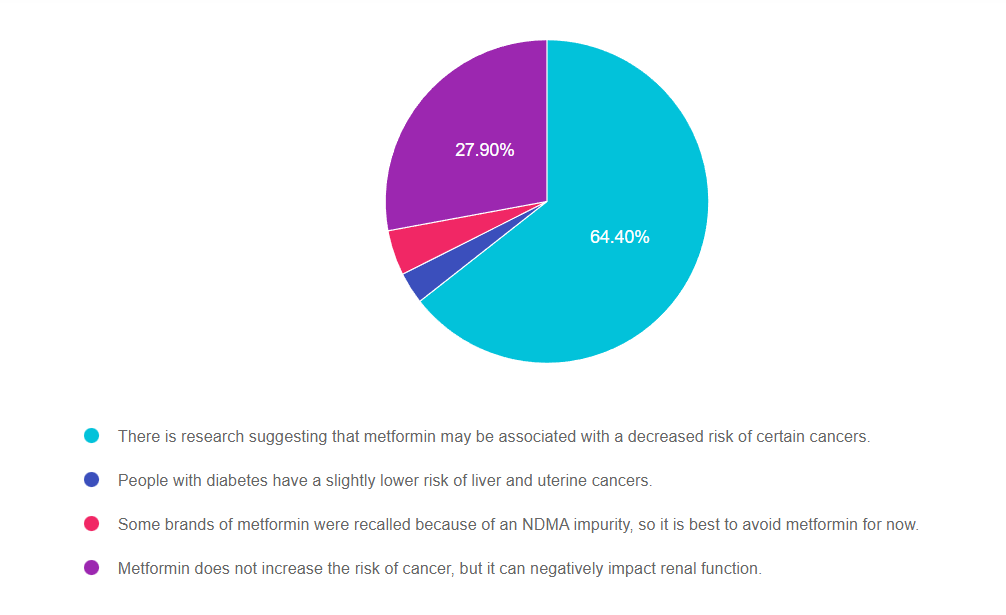
Getting to the Best Answer
Answer 1 is correct. 64.40% chose this answer, “There is research suggesting that metformin may be associated with a decreased risk of certain cancers.” YES, this is the best answer, GREAT JOB. Research is showing that metformin decreases risk of DNA replication disruption, improves cellular health and increases telomere length. In addition, it enhances intestinal microbial diversity, decreases inflammation and lowers glucose levels. There are many research studies investigating metformin’s potential for cancer prevention and improvement of treatment outcomes.
Answer 2 is incorrect. 3.17% of you chose this answer, “People with diabetes have a slightly lower risk of liver and uterine cancers.” People with diabetes are actually at higher risk for liver, pancreas and breast cancer. Researchers aren’t sure exactly why, but insulin resistance, extra body weight, and DNA replication disruption in addition to genetics and social determinants of health, all seem to play a part.
Answer 3 is incorrect. 4.52.% of respondents chose this answer, “Some brands of metformin were recalled because of an NDMA impurity, so it is best to avoid metformin for now.” Since the NDMA impurity was recognized, manufacturing processes were improved to prevent future contamination. Metformin is an important treatment option for people living with diabetes.
Finally, Answer 4 is incorrect. 27.90% chose this answer, “Metformin does not increase the risk of cancer, but it can negatively impact renal function.” Metformin does NOT harm the kidneys. As a matter of fact, metformin protects the kidneys by lowering blood sugars and decreasing inflammation. It is true that people with a GFR below 30, need to avoid metformin to prevent lactic acidosis, however this a VERY rare complication. Metformin is the most widely used diabetes medication world-wide and it has an excellent safety profile. Bonus note, metformin ER causes less GI upset and costs the same as the non-extended release version ($4 a month).
Thank you so much for reading this “Rationale of the Week”. You can download our Medication PocketCard, for more information.
Want to learn more about this question? Join us for our
Level 4 | Cancer and Diabetes | 1.25 CEs
Recorded & Ready for Viewing!
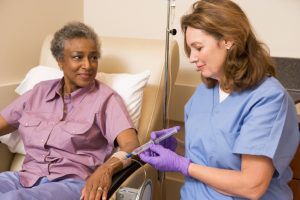
Diabetes Education Services Online University Courses are an excellent way to study for your exam anytime and anywhere that is convenient for you. You will have immediate access to your courses for 1 year after your purchase date. Each individual online course includes a: video presentation, podcast, practice test and additional resources.
Patients with cancer often experience hyperglycemia secondary to treatment, which can increase risk of infection and compromise their nutritional status. In addition, recent research has identified the link between diabetes and cancer. Join us to learn more about this unexpected link and treatment strategies for steroid induced hyperglycemia using a case study approach.
Objectives:
- Discuss the relationship between cancer, hyperglycemia and insulin resistance.
- State 3 benefits of normalizing glucose levels during chemotherapy.
- Using a case study approach, discuss strategies to improve glucose levels and quality of life.
Intended Audience: These courses are knowledge-based activities designed for individual or groups of diabetes educators, including RNs, RDs, Pharmacists, Nurse Practitioners, Clinical Nurse Specialists, Physician Assistants and other health care providers interested in enhancing their knowledge of diabetes management for people with cancer.
Don’t worry if you can’t make it live. Your registration guarantees access to the recorded version in the Online University.
All hours earned count toward your CDCES Accreditation Information
Sign up for Diabetes Blog Bytes – we post one daily Blog Byte from Monday to Friday. And of course, Tuesday is our Question of the Week. It’s Informative and FREE! Sign up below!
The use of DES products does not guarantee the successful passage of the CDCES exam. CBDCE does not endorse any preparatory or review materials for the CDCES exam, except for those published by CBDCE.
Biscuit & Muffin – Welcome to Bryanna’s Cat Bakery
In the summer of 2021, I decided it was time to get my first pet as an adult. I had just bought my first home and felt I finally had the space to get an animal.

I looked on my local shelter’s website and immediately fell in love with Biscuit. She’s a Calico with striking green, grumpy eyes. Her profile said she had been in the shelter for a long time and wasn’t doing well in that environment. I knew I wanted to bring her home where she could feel safe. I filled out an application and set up an appointment to see her. The next day she came home.
When she arrived, she immediately hid under the couch, unsure of where she was. I sat on the floor with her for a while until she felt okay enough to come out. It took many months for her to feel comfortable, and though at times she is still very anxious, she has relaxed enough to let her personality shine through. She is silly, loves to snuggle, and has a lot of cattitude.

Due to all of her progress, I thought she now might enjoy a friend to hang out with.
In November, I checked my local shelter’s website again and saw Muffin, who like Biscuit, is a Calico with beautiful eyes. Again, I contacted the shelter and went to pick her up. For the first three days, I kept both cats in separate areas of the house, while slowly introducing them over the past few weeks.
Every day, Muffin is building her confidence in her new home; she is very curious, sweet, and loves to play.
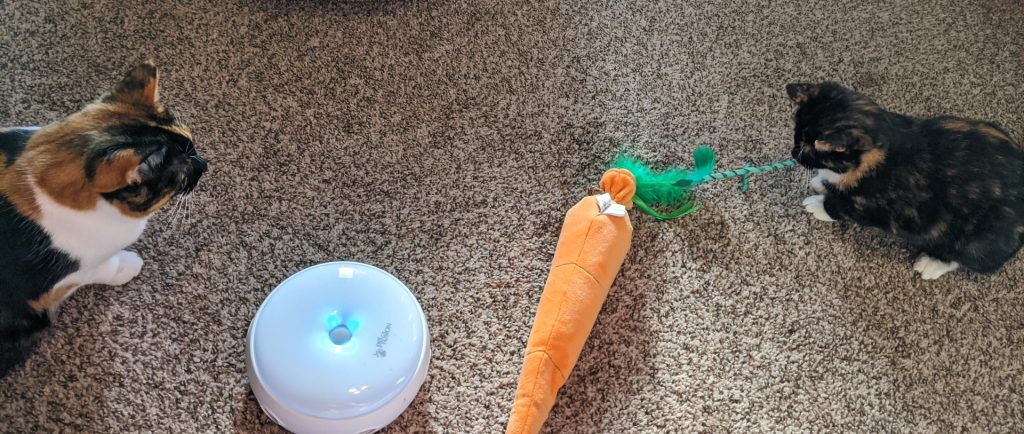
Biscuit is still struggling with a new cat in the house, but they are slowly making progress and spending more time together. Muffin loves to follow Biscuit around and mimic what she is doing. I have even caught them laying down next to each other.
I know it will take more time until they become friends, but I am so joyful their relationship is growing.
Written by Bryanna, our Director of Operations & Customer Happiness
Sign up for Diabetes Blog Bytes – we post one daily Blog Byte from Monday to Friday. And of course, Tuesday is our Question of the Week. It’s Informative and FREE! Sign up below!
The use of DES products does not guarantee the successful passage of the CDCES exam. CBDCE does not endorse any preparatory or review materials for the CDCES exam, except for those published by CBDCE.



